Indexed In
- Open J Gate
- Genamics JournalSeek
- JournalTOCs
- Ulrich's Periodicals Directory
- RefSeek
- Hamdard University
- EBSCO A-Z
- OCLC- WorldCat
- Proquest Summons
- Publons
- Geneva Foundation for Medical Education and Research
- Euro Pub
- Google Scholar
Useful Links
Share This Page
Journal Flyer

Open Access Journals
- Agri and Aquaculture
- Biochemistry
- Bioinformatics & Systems Biology
- Business & Management
- Chemistry
- Clinical Sciences
- Engineering
- Food & Nutrition
- General Science
- Genetics & Molecular Biology
- Immunology & Microbiology
- Medical Sciences
- Neuroscience & Psychology
- Nursing & Health Care
- Pharmaceutical Sciences
Research Article - (2023) Volume 14, Issue 6
Voluntary Blood Donation Barriers and Motivational Factors among the Copperbelt University Students in Kitwe, Zambia
Whyson Mwale*Received: 03-Feb-2023, Manuscript No. JBDT-23-19762; Editor assigned: 06-Feb-2023, Pre QC No. JBDT-23-19762 (PQ); Reviewed: 20-Feb-2023, QC No. JBDT-23-19762; Revised: 18-Apr-2023, Manuscript No. JBDT-23-19762 (R); Published: 25-Apr-2023, DOI: 10.4172/2155-9864.23.14.571
Abstract
Introduction: Blood transfusion is an important component of the health care system of every country. Patients with medical conditions like anemia, severe post-partum hemorrhage and acute blood loss in surgery and road accidents require this process for their lives. Blood can’t be manufactured hence blood donation remains the only way in which blood banks in medical facilities can acquire blood for the patients who need blood transfusions. This can only be achieved when more people donate blood voluntarily. Ensuring that more people donate blood voluntarily, blood donors’ motivators and barriers to blood donation must be understood equally important is to note the knowledge levels of the donors about blood donation.
Objectives: This study aims at assessing potential barriers and motivational factors towards blood donation among the copperbelt university students in Kitwe.
Methodology: A descriptive cross section study was conducted university students at the copperbelt university in Kitwe. A random sampling technique was used to sample out 354 participants in this study. Data was collected using well-structured questionnaires that were administered to participants by the researcher. The computer software SPSS version 26.0 was used for data management during data entry and analysis.
Expected outcomes include proportions of university students who have donated blood at least once. The study established challenges faced by blood donors in form of barriers and also motivational factors for blood donation among those who have donated at least once and those intending to donate once an opportunity comes up. This is an important study because the findings will be useful in developing strategies in scaling up blood donations among university students in Zambia.
Results: The study comprised of 354 participants of which 196 (57.3%) were males and 146 (42.7%) were females. Age of participants, 18-20 years (23.1%), 21-25 years (73.1%) and >=26 (3.8%). Out of the 354 participants, only 66 (19.3%) had donated blood before while majority 276 (80.7%) of them had not donated blood before. More than three-quarters 53 (80.3%) of those who had donated before were males. There was significant relationship between donation status and gender equally with knowledge levels.
The study showed that the majority of the participants had good knowledge concerning blood donation and the majority of those who had donated blood before were knowledgeable about blood donation.
Keywords
Blood donors; Blood donation; Motivators; Barriers; Knowledge
Abbreviations
WHO: World Health Organization; CIDRZ: Center for Infectious Diseases Research in Zambia; ZNBTS: Zambia National Blood Transfusion Service; ZADP: Zambia Anesthesia Development Program; UTH: University Teaching Hospital; MOH: Ministry of Health; NHS: National Health Service; UK: United Kingdom; TDRC: Tropical Disease and Research Centre.
Introduction
Blood donation for transfusion is an important step in the management of many clinical problems with indications of anemia and acute blood loss as in surgery, road accident and severe post-partum hemorrhage [1]. Blood is an important component of the human body which is essential to life. Since blood cannot be manufactured artificially, blood donation remains an essential process to save people's lives. In most of the countries, blood donation system is by family replacement donors who donate blood to help a friend or family member in need of blood transfusion. Such blood donation system rarely meet the clinical demand of blood and has resulted into shortage of blood for surgical procedures and other medical procedures in hospitals across the country and worldwide.
There has been challenges relating to availability, quality and safety of blood for patients in need of blood transfusion. These challenges may have been due to quality assurance measures by the world health organization. For instance in order to ensure blood quality and safety, the World Health Organization (WHO) tightened the criteria on blood donation by confining it to voluntary blood donors only unlike paid donors. This has since been further associated with shortage of blood in blood banks as the willingness of people to donate blood voluntarily differs. In trying to overcome this problem, the US government established a national blood collection program in 1940. Around 1941, the red cross launched a first nationwide blood program for civilians by opening its collection center in Rochester NY Emily Wheeler, et al. A recent survey conducted in the US showed a sharp increase in the demand for blood transfusions in a period of 10 years from 1.1 million transfusions in 1997 to 2.7 million in 2007 Jose AG, et al.
With regards to the knowledge of blood donation, various studies have shown that the more knowledgeable an individual is about the importance of blood donation, the higher the chances of donating blood [2]. The study conducted at Mekelle university in Ethiopia showed that 95% of the respondents who had a favorable attitude to blood donation where those with high school certificate. Hence, the perception towards blood donation could largely be influenced by the extent of knowledge an individual has. In China, the statistical data in an article published by blood donors management of China Stevens L, et al. shows that China still faces many challenges with its blood management system despite a steady increase in total blood collections and voluntary blood donors.
In Africa, blood transfusions were initiated in a few colonies of Sub-Saharan Africa which expanded until the last years of colonial period in early 1960’s. The most interesting feature of African records on blood transfusions is that the number of transfusions reported in each country grew by orders of magnitude in each decade. However in the British colonies of East and West Africa there were more frequent reports of difficulties in finding blood donors. The reports showed that a good number of people feared to lose blood that could not be replaced. This reveals lack of understanding of human physiology [3].
In Zambia due to increased demand for blood and blood products, Centre for Infectious Diseases Research in Zambia (CIDRZ) collaborated with Zambia National Blood Transfusion Service (ZNBTS) to conduct a blood drive for its employees to donate blood to blood banks. The ZNBTS also established provincial blood transfusion centers in all the 10 provinces to mobilize more blood donors Banda, et al. Therefore, this study determined the motivational factors for blood donation and the barriers to it among blood donors and non-blood donors among students at Copperbelt university riverside campus in Kitwe, Zambia.
Statement of the problem
Blood donation is a lifesaving process hence the need to have an effective way of ensuring that more people aspire to donate blood. Zambia has a high prevalence rate of anemia and pregnancy related complications whose treatment involves blood transfusion. Besides the high prevalence rate of the stated conditions, surgical procedures also require blood availability. Lack of blood availability will lead to loss of lives in these cases as captured in the report from the case study done by ZNBTS and Zambia Anesthesia Development Program (ZADP) at University Teaching Hospital in Lusaka, Zambia (UTH).
The study observed that 30% of hemorrhagic deaths are due to lack of blood availability (hemorrhage and transfusion, 2015).
Globally, Zambia has a very low blood donation rate of 4.6% of 1000 population per year (WHO global database on blood safety, 2013). Therefore, this study aimed at determining the motivational factors and barriers to blood donation among donors and non-blood donors [4].
Study justification
The results obtained from this study will be used by different public health organizations and Ministry of Health (MOH) as baseline information for future larger studies to be conducted in the country concerning blood donation and transfusions services. This will help in coming up with diverse strategies that will be used to sensitize the general public on the importance of blood donation through publishing media. People will have the desire to donate blood when they get clear information on the importance of blood donation and the country is likely to have a high donation rate that will ensure sustainable availability of blood in hospitals across the country. This will benefit a lot of patients whose medical conditions requires blood transfusion.
About the study
Blood donation is a voluntary process of giving out blood with the purpose of saving someone's life. According to world health organization, voluntary blood donation is the reliable way of ensuring sufficient supply of safe blood to meet national requirement of blood transfusion. Increased cases of road traffic accidents and postpartum hemorrhage has directly attributed to increased demand for blood transfusion. Unfortunately, studies have demonstrated a decreased rate of blood donation across each nation and worldwide.
Globally: Based on the data reported by 180 countries between 2011-2013, the WHO estimated approximately 112.5 million units of blood were being collected annually. This statistic is an indication of how urgent the matter of recruiting more donors is of concern. Recruitment will mean determining the motives and barriers to blood donation from which possible motivators will be put in place to ensure more donors. Many countries both developed and non-developed have since been facing problems with the unpaid donor system. This brings to our insight as to what encourages a person to donate blood for free. The United States reports of 2011-2013 on blood donation showed that 37% of populations are eligible donors of which less than 10% of these donate blood annually. Other reports from National Health Service (NHS) in United Kingdom (UK), stipulated that blood donation levels in UK is 4% while that of Canada is 3.5% (guidelines for United Kingdom blood services, 2008). Much as we differ in how we perceive the world, different groups of people have got different attitudes and knowledge about blood donation [5]. The comprehensive study was done at King Abdulaziz medical city in Saudi Arabia that aimed at measuring the awareness, knowledge, beliefs and both negative and positive attitudes of people towards blood donation. The study showed that 78.6% of those involved in a research perceived blood donation as total altruism while 71.3% claimed that blood donation is a religious duty. The difference in awareness was due to the difference in traditions, cultures, religion and level of education. Another study conducted in Central Saudi Arabia showed a very low prevalence of blood donation compared to the country's population. The low prevalence is probably due to misconceptions, poor knowledge and negative attitude to blood donation.
Regionally: In Africa, most countries collect half of the blood required to meet transfusion requirements of their populations Harry BE, et al. Ethiopia is one of the countries in Africa with high maternal mortality (676 per 100000) and high motor accident rate hence the need of high blood donation rate. Despite the high demand in blood, Ethiopia has a least number of voluntary blood donors, 22% of the country's population. Ethiopian's average annual national requirement for blood is 100000 units per year, but only 43% of the required amount is collected Elias S, et al. This shows that the availability and safety of blood is still inadequate to meet the increased demand of blood and blood components in Africa [6]. A recent study that was conducted at tamale teaching hospital, Northern region of Ghana which aimed at assessing the factors that motivates people to donate blood. The study yielded 90.3% donors who were motivated to donate blood only when someone they know or family member is in need of blood transfusion. Indeed, most of the blood donation in Africa is largely dependent on family replacement donor who can only donate blood to a family in need of blood transfusion because of the belief that blood is a sacred substance [7]. About 34% of maternal deaths in Africa are still attributed to severe bleeding during and after childbirth hence, the need of educating the communities on the importance of blood donation. High levels of awareness and knowledge on importance of blood donation will ensure dismissal of Africans myths and fears related to blood donation.
Nationally: According to Zambia national strategic plan 2017-2021, there is no upward trend in the number of blood units collected per annum from 2011 to 2015. The report shows that there was a decline in repeat donors from 56% in 2012 to 47% in 2015. There is less evidence of studies about voluntary blood donation in Zambia. Hence, the valid reasons as to why there is a decrease in blood units collected per year are not known. This calls for the purpose of this research to determine what will motivate donors and the barriers for blood donation.
Objectives
General objectives: To assess the potential barriers and motivations towards blood donation among university students in Kitwe.
Specific objectives
• To determine the proportion of university students in Kitwe,
Zambia that have ever donated blood voluntarily.
• To determine the proportion of university students who are
knowledgeable about blood donation.
• To determine motivational factors for blood donation among
university students in Kitwe, Zambia.
• To determine barriers to voluntary blood donation among
donor and non-donor university students in Kitwe, Zambia.
• To determine factors associated with ever been a blood donor
among university students in Kitwe, Zambia.
Research questions
• What is the proportion of students that have donated blood at
least once?
• What is the proportion of university students who have
adequate knowledge about blood donation?
• What are the motivational factors for blood donor and nondonor
university students?
• What are the potential barriers for blood donation among
university students?
• What factors are associated with ever donated blood
voluntarily among university students?
Measurements
Operational definitions
• Blood donor: A person aged between 18 to 60 years who
donates blood at least once in three (3) months.
• Non-blood donor: A health person aged 18 to 60 years
who doesn’t donate blood.
• Voluntary blood donor: A person who donate blood with
the aim of saving anyone’s life other than just for family
member.
• Motivators: Factors that drives an individual to donate blood.
• Barriers: Factors that hinders an individual from donating
blood.
Scales of measurements
The results shown in Table 1.
| Type of variable | Variable | Indicator |
|---|---|---|
| Dependent | Ever-donated blood | Blood donor/non-blood donor |
| Independent | Knowledge | Knowledge will be measured by the knowledge questions: 8/9; knowledgeable 5-7; moderate knowledge Less than 4; poor knowledge. |
| Attitude | Positive: Willing to donate blood. Negative: Unwilling to donate blood. |
|
| Family replacement | Situation at which one donate blood | |
| Education | Level of education when one came to know the importance of blood donation. | |
| Gender | Male/female | |
| Extraneous | Disease | Pathological conditions that hinders one to donate blood. |
| Medicine | Medications that hinders blood donation. |
Table 1: List of variables.
Conceptual framework
Proportion of students donating blood is expected to be high among students due to following (motivational factors):
• Knowledgeable about blood donation.
• Certain age group.
• Particular gender.
• Certain religious denomination.
• Cultural background.
• Myths.
• Have had a family member who received donated blood.
• Incentive.
• Social/friendly healthcare staff collecting blood.
• Clear identification of healthcare workers (GRZ vehicle,
equipment, uniforms etc.
The proportions of students donating blood is expected to be low among students due to the following (barriers):
• Lack of knowledge about blood donation.
• Certain age group.
• Particular gender.
• Certain religious denomination.
• Cultural background.
• No history/or have had a family member who received
donated blood.
• No incentive.
• Unfriendly healthcare staff collecting blood.
• Lack of clear identification of healthcare workers (GRZ
vehicle, equipment, uniforms etc.) (Figure 1).
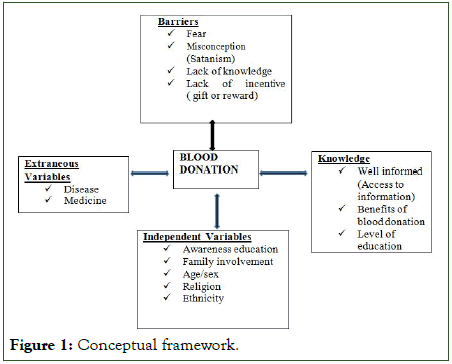
Figure 1: Conceptual framework.
Materials and Methods
Study site
The study was conducted at the copperbelt university riverside campus in Kitwe town. Kitwe is the third largest city in Zambia and is found on the copperbelt with approximated population of 687,245. The copperbelt university is the second largest public university in Zambia [8-12]. It has 8 schools and 2 academic directorates spanning through all the campuses. It was established in 1987 and has an estimated number of 11,000 students every academic year. The university houses both local and international students 8 different schools.
Target population
The study was done among university students both male and female who have donated blood and those who have not donated blood before with the age range of 18 years-35 years.
Study design
Descriptive cross-sectional study was used to carry out this study which enabled it to achieve its objectives. The study was conducted in a period of four months in 2022.
Sample size
The sample size was determined in order to select a representative sample size of the university students. Using a one sample proportion formula and the information on the Table 2 below, a sample size of 354 was determined [13].
N=p(1-p)(Z/E)2
N=0.36(1- 0.36)(1.96/0.05)^2
=0.2304(1536.64)
=354
N=sample size
P=population proportion
Z=level of confidence
E=margin of error.
| Level of confidence measure | 1.96 (at 95% confidence level) |
| Margin of error | 5% |
| Population proportion | 36% |
Table 2: Information on sample size calculation.
Sampling
The sampling method used was systematic random sampling. The advantage was that each participant had an equal chance of being in the study and there was no sampling bias.
Inclusion and exclusion
Inclusion criteria: The study involved collection of data only from copperbelt university students of riverside campus in Kitwe in any year of study who approved participation by signing of the consent form [14].
Exclusion criteria: Copperbelt university students who were absent on the day/time of administration of questionnaires and those who were not willing to sign the consent form.
Data collection
The data collected was primary data in that the questionnaires were directly administered to students. Data was collected using a semi-structured questionnaires that was administered to all participants by a researcher. The questionnaire contained section that covered socio-demographic data and the other section for assessing the motivation factors and potential barriers to blood donation. The data collection was carried out by the researcher for a period of two months.
Data management and analysis
The data collected comprised of both soft copy data and hard copy data. The soft copy data was backed up in other computers while hard copy data was put in a file then put away in a safe place.
In order to achieve the objectives, quantitative analysis was done after data was collected and coded. The data collected was entered and analyzed using SPSS version 26. Obtained results were tabulated in tables of frequencies and percentages and tested using a Chi-square test to determine the association between donor status and motivation for blood donation and barriers for blood donation [15]. Knowledge was measured by knowledge questions: 8/9 knowledgeable, 5-7/9 moderately and less than 4 poor knowledge.
Results
Introduction
This chapter focuses on the data analysis with the view of establishing the main findings with respect to the research questions. The analysis of data was guided by the following research objectives: To assess the potential barriers and motivations towards blood donation among Copperbelt university students in Kitwe and the results are presented according to the way research questions are arranged.
Demographic characteristics
Response rate: Research questionnaires were printed and distributed randomly among students at the copperbelt university, riverside campus. The total number of potential respondents was three hundred and fifty-four (354) students. The number of administered questionnaires were 360 however, 342 questionnaires were completed out of the targeted 354. The response rate therefore, (342/360) x 100 came out to 95%.
Age of respondents: The findings in Figure 2 revealed that the majority of the respondents fell in the range of 21-25 years age category with 250 respondents representing 73.1%. Those aged between 18-20 years were 79, representing 23.1%. Meanwhile those aged 26 and above were the lowest representing 3.8% with 13 respondents. The minimum and maximum age was 18 years and 29 years respectively while the mean age was 22.23.
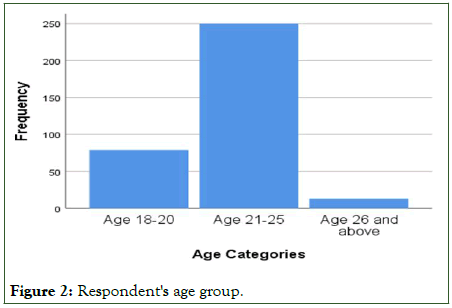
Figure 2: Respondent's age group.
Respondent’s gender: Majority of the respondents 196 were males representing 57.31% while 146 respondents were females representing 42.76%. This shows that more male students than female students participated in the study as shown in Figure 3 below.
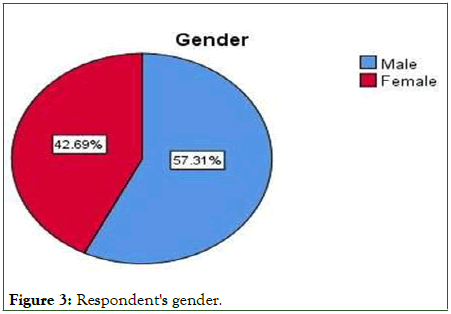
Figure 3: Respondent's gender.
Year of study of respondents: The distribution of participants according to the year of study was as follows: First years were the majority with 32.75%, second year (18.13%), third year (16.37%), fourth years (19.30%) and fifth years (13.45%) (Figure 4).
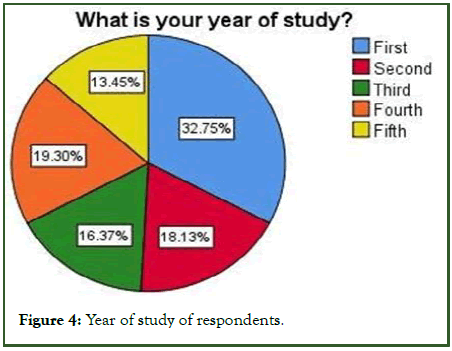
Figure 4: Year of study of respondents.
Religion of respondents: The majority of the respondents, 339 students representing 99.12% were Christians while 0.88% were Muslims (Figure 5). Since Zambia is a Christian nation, the participants gave their knowledge and views on blood donation based on their Christianity beliefs.
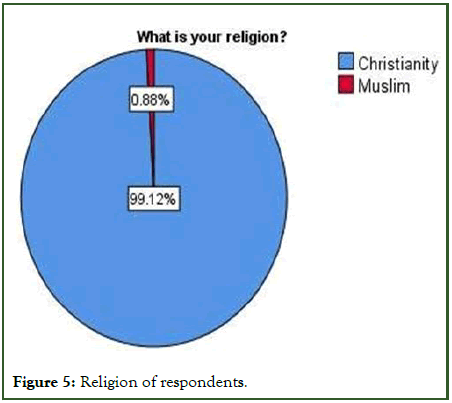
Figure 5: Religion of respondents.
Have you ever donated blood before?: Figure 6 below shows that only 19.30% of participants have donated blood before while the majority of the participants 80.70% have never donated before.
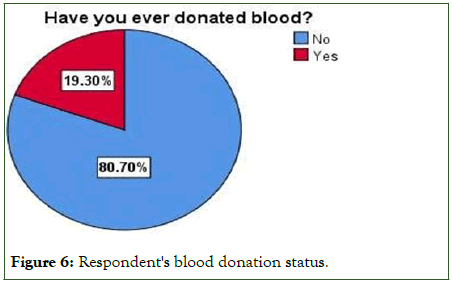
Figure 6: Respondent's blood donation status.
Social demographic characteristics associated with those who have donated blood before: The Table 3 below shows some factors associated with those who have donated blood before. After the data was analyzed, it was noted that majority (97%) of the donors had donated to someone they don’t know while 3% had donated to their relatives. More than half (86.40%) made the donation at school. The results also showed that 57.60% of donors voluntarily donated while others 42.40% were asked to donate. Most of the donors 63.60% received incentives after donating. It was also noted that majority of the donors 66.7% had their first donation at secondary school and the minority (7.60%) at primary school. It was also noticed that among the donors only 6.10% of them felt ill after donating blood while the majority 93.9% were normal after making a donation.
| Variable | Frequency | Percent | |
|---|---|---|---|
| Ever donated blood before | No | 276 | 80.70% |
| Yes | 66 | 19.30% | |
| Donated to | Unknown | 64 | 97.00% |
| Family member | 2 | 3.00% | |
| Donated at | School | 57 | 86.40% |
| Hospital/clinic | 9 | 13.60% | |
| Received incentives | No | 24 | 36.40% |
| Yes | 42 | 63.60% | |
| Asked to donate? | No | 38 | 57.60% |
| Yes | 28 | 42.40% | |
| Level of education at which you started donating blood | Primary school | 5 | 7.60% |
| Secondary school | 44 | 66.70% | |
| College/university | 17 | 25.80% | |
| How you felt after donating blood | Ill | 4 | 6.10% |
| Normal | 62 | 93.90% |
Table 3: Frequency of social demographic characteristics associated with those who have donated blood before.
Knowledge regarding blood donation
In order to assess knowledge about blood donation, 9 questions were answered with total score of 9. In this study, each question was given one (1) point for a correct answer and zero (0) for incorrect response. Table 4 below shows the frequency for the scores which were scored by different participants. An overall knowledge score for each participant was calculated by adding up the scores and the frequency for each score was analyzed as shown in Table 4.
Knowledge level for blood donation was categorized as follows: Score of 4 and below; poor knowledge, score of 5-7; moderate knowledge and score of 8 and above; knowledgeable. Figure 7 below shows that there were 11 (3.22%) participants with poor knowledge regarding blood donation, 105 (30.70%) of them had moderate knowledge while more than half of the participants had good knowledge about blood donation and represented 66.08% (Supplementary Table 1).
| Score/9 | Frequency | Percent | Valid percent | Cumulative percent |
|---|---|---|---|---|
| 3 | 4 | 1.2 | 1.2 | 1.2 |
| 4 | 7 | 2 | 2 | 3.2 |
| 5 | 15 | 4.4 | 4.4 | 7.6 |
| 6 | 37 | 10.8 | 10.8 | 18.4 |
| 7 | 53 | 15.5 | 15.5 | 33.9 |
| 8 | 103 | 30.1 | 30.1 | 64 |
| 9 | 123 | 36 | 36 | 100 |
| Total | 342 | 100 | 100 |
Table 4: Frequency of knowledge scores.
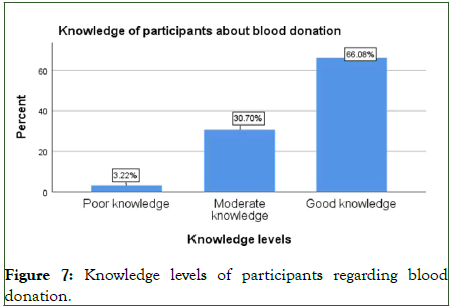
Figure 7: Knowledge levels of participants regarding blood donation.
Motivational factors for blood donation
As part of determining motivational factors for blood donation, donors (66 participants) were asked to select potential factors on the questionnaire and also list the other factors which motivated them to donate blood. Multiple response analysis was done on the selected motivational factors. Figure 8 below shows that helping someone in need was selected the most 52 (33.99%) followed by being knowledgeable about blood donation 39 (25.49%). This entails that most of the donors are highly motivated to donate blood because of the need to help someone in need and because they are knowledgeable about blood donation. Religion and blood needed by a friend/relative had least influence on the donor’s need to donate blood as they were selected the least 6 (3.92%) in relation to the other factors.
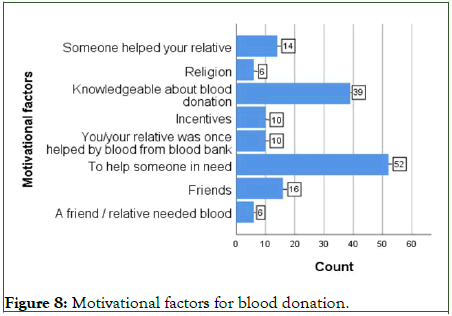
Figure 8: Motivational factors for blood donation.
Potential barriers for blood donation
As part of determining barriers for blood donation, non-blood donors (276 participants) were asked to select the potential barriers on questionnaire and also list any other factors that hinder them to donate blood. After multiple analysis of the selected factors, it was noticed that fear of injection/hospital/health workers was the most commonly selected 43.4% barrier to blood donation. This was followed by fear of being anemic which was selected by 34.6% of participants and lack of knowledge selected by 87 (32.0%) participants (Table 5). 29.4% of participants not being interested in donating blood and 25.4% have never had an opportunity of donating blood. Few of the participants (5.1%) were hindered by their religious beliefs.
| Barriers for blood donation frequencies | ||||
|---|---|---|---|---|
| Responses | Percent | Percent of cases | ||
| Barriers for blood donation | Religion | 14 | 2.80% | 5.10% |
| Lack of knowledge | 87 | 17.60% | 32.00% | |
| No opportunity | 69 | 14.00% | 25.40% | |
| Fear of injection/hospital/healthcare workers | 118 | 23.90% | 43.40% | |
| Not interested | 80 | 16.20% | 29.40% | |
| Underlying medical condition | 32 | 6.50% | 11.80% | |
| Fear of being anemic after donation | 94 | 19.00% | 34.60% | |
| Total | 494 | 100.00% | 181.60% | |
Table 5: Barriers for blood donation.
Respondent’s specific reasons for not donating blood: The Table 6 below shows some specific reasons why some participants do not donate blood. Fear of death was the most common listed barrier to blood donation, listed by 4 participants. The rest of the reasons which includes:
• Better to use alternative ways than human blood (usage of
ginnea pigs).
• The facilities carrying out blood donation are far from campus
and health personnel rarely come in campus to carry out
blood donation process.
• Fear of the blood being tested without the donor’s knowledge.
• Being misinformed about blood donation were each listed by
2 participants (Tables 7-11).
| Frequency | Percent | Valid percent | Cumulative percent | ||
|---|---|---|---|---|---|
| Valid | 263 | 95.3 | 95.3 | 95.3 | |
| Other barriers (specific) | Better to use other ways rather than human blood (usage of ginnea pigs). | 2 | 0.7 | 0.7 | 96 |
| Facilities carrying out blood donation are far from campus and health personnel rarely come in campus). | 2 | 0.7 | 0.7 | 96.7 | |
| Fear of death. | 3 | 1.1 | 1.1 | 97.8 | |
| Fear of my blood being tested without my knowledge. | 2 | 0.7 | 0.7 | 98.6 | |
| I feel like I will die after donating. | 2 | 0.7 | 0.7 | 99.3 | |
| I was misinformed about blood donation. | 2 | 0.7 | 0.7 | 100 | |
| Total | 276 | 100 | 100 |
Table 6: Participant’s specific reasons for blood donation barriers.
| Association between gender and blood donation status | |||||
|---|---|---|---|---|---|
| Variables | Gender Total | Total | Chi-square test (p value) | ||
| Male | Female | ||||
| Have you ever donated blood? | No | 143 | 133 | 276 | <0.001 |
| Yes | 53 | 13 | 66 | ||
| Total | 196 | 146 | 342 | ||
Table 7: Shows association between gender and blood donation status.
The relationship between gender and blood donation status was statistically significant hence creating a correlation.
| Association betweenreligion of participants and their blood donation status | |||||
|---|---|---|---|---|---|
| Variables | What is your religion? | Total | Chi-square test (p value) | ||
| Christianity | Muslim | ||||
| Have you ever donated blood? | No | 273 | 3 | 276 | 0.395 |
| Yes | 66 | 0 | 66 | ||
| Total | 339 | 3 | 342 | ||
Table 8: Shows association between religion and blood donation status.
There was no correlation between respondent’s religion and their blood donation status.
| Association between knowledge levels of participants and their blood donation status | ||||||
|---|---|---|---|---|---|---|
| Variables | Knowledge levels | Total | Chi-square (p value) | |||
| Poor knowledge | Moderate knowledge | Good knowledge | ||||
| Have you ever donated blood? | No | 11 | 91 | 174 | 276 | 0.03 |
| Yes | 0 | 14 | 52 | 66 | ||
| Total | 11 | 105 | 226 | 342 | ||
Table 9: Shows association between knowledge levels and blood donation status.
The relationship between knowledge levels of participants and their blood donation status was statistically significant hence creating a correlation.
| Association between age categories of participants and their blood donation status | ||||||
|---|---|---|---|---|---|---|
| Variables | Age categories (years) | Total | Chi-square (p value) | |||
| Age 18-20 | Age 21-25 | Age 26 and above | ||||
| Have you ever donated blood? | No | 69 | 196 | 11 | 276 | 0.2 |
| Yes | 10 | 54 | 2 | 66 | ||
| Total | 79 | 250 | 13 | 342 | ||
Table 10: Shows association between age categories of participants and blood donation status.
There was no correlation between age categories of participants and their blood donation status.
| Have you ever donated blood? *Incentives cross tabulation | |||||
| Count | Incentives | Total | Chi-square (p value) | ||
| No | Yes | ||||
| Have you ever donated blood? | No | 2 | 2 | 4 | 0.073 |
| Yes | 56 | 10 | 66 | ||
| Total | 58 | 12 | 70 | ||
| Have you ever donated blood? *Knowledgeable about blood donation cross tabulation | |||||
| Count | Knowledgeable about blood donation | Total | Chi-square (p value) | ||
| No | Yes | ||||
| Have you ever donated blood? | No | 2 | 0 | 2 | 0.046 |
| Yes | 27 | 39 | 66 | ||
| Total | 29 | 39 | 68 | ||
| Have you ever donated blood? *Someone helped your relative Cross tabulation | |||||
| Count | Someone helped your relative | Total | Chi-square (p value) | ||
| No | Yes | ||||
| Have you ever donated blood? | No | 2 | 0 | 2 | 0.465 |
| Yes | 52 | 14 | 66 | ||
| Total | 54 | 14 | 68 | ||
| Have you ever donated blood? *You/your relative was once helped by blood from blood bank Cross tabulation | |||||
| Count | You/your relative was once helped by blood from blood bank | Total | Chi-square (p value) | ||
| No | Yes | ||||
| Have you ever donated blood? | No | 2 | 0 | 2 | 0.551 |
| Yes | 56 | 10 | 66 | ||
| Total | 58 | 10 | 68 | ||
| Have you ever donated blood? *To help someone in need Cross tabulation | |||||
| Count | To help someone in need | Total | Chi-square (p value) | ||
| No | Yes | ||||
| Have you ever donated blood? | No | 0 | 2 | 2 | 0.024 |
| Yes | 14 | 52 | 66 | ||
| Total | 14 | 54 | 68 | ||
| Have you ever donated blood? *A friend/relative needed blood Cross tabulation | |||||
| Count | A friend/relative needed blood | Total | Chi-square (p value) | ||
| No | Yes | ||||
| Have you ever donated blood? | No | 2 | 0 | 2 | 0.655 |
| Yes | 60 | 6 | 66 | ||
| Total | 62 | 6 | 68 | ||
| Have you ever donated blood? *Religion cross tabulation | |||||
| Count | Religion | Total | Chi-square (p value) | ||
| No | Yes | ||||
| Have you ever donated blood? | No | 262 | 14 | 276 | 0.211 |
| Yes | 60 | 6 | 66 | ||
| Total | 322 | 20 | 342 | ||
| Have you ever donated blood? *Friends cross tabulation | |||||
| Count | Friends | Total | Chi-square (p value) | ||
| No | Yes | ||||
| Have you ever donated blood? | No | 4 | 0 | 4 | 0.262 |
| Yes | 50 | 16 | 66 | ||
| Total | 54 | 16 | 70 | ||
Table 11: Associations of motivation factors and blood donation status of participants.
Discussion
Introduction: To meet the blood transfusion demand and ensure adequate and constant supply of blood in all hospitals where blood transfusion is performed, it is essential to understand the motivators and barriers to blood donation for the formulation and effective implementation of donor recruitment programmes. This study determined the motivational factors and potential barriers for blood donation among copperbelt university students. It also revealed the knowledge levels of students about blood donation and its association to the blood donation status.
Demographics: This study comprised of 354 participants of which 196 (57.3%) were males and 146 (42.7%) and the age range was between 18 and 29 years. The majority of the participants (73.1%) were between 21-25 years and the mean age of participants in this study was 22.23 (SD=2.059) years. This study was slightly consistent with a study done in Ghana by Shamsudeen M, et al. that showed the average age of participants was between 20-35 years. There was no relationship between age categories of participants and their blood donation status (p value=0.200). Majority of participants were in their first year and almost all the participants were Christians.
Results from this study also revealed that the majority of the participants 276 (80.70%) had not donated blood before, only 66 (19.30%) had donated blood at least once. After cross tabulating gender and donor status, it was noted that more males 53 (80.30%) had donated blood compared to females 13 (19.7%). This was consistent with the findings of a study done in Saudi Arabia by Abolfotouh M, et al. which showed that donation was significantly more prevalent among males 66%than females 13.3%. In this study, an association existed between participants’ gender and their blood donation status (p value of <0.001).
Knowledge of participants on blood donation: On the knowledge levels, from the data which was analyzed, most of the students had good knowledge (66.1%) on blood donation with only 3.22% having poor knowledge. Interestingly, the results showed that most of the participants who have donated blood before had a good knowledge about blood donation. This tells that higher knowledge score is a significant predictor of blood donation. The study revealed a statistically significant relationship between knowledge levels of participants and their blood donation status (p value=0.030).
Motivators for blood donation: The summary of motivation factors selected by the participants are presented on Figure 8. More than half of the participants endorsed two motivators for blood donation; to help someone in need 52 (78.8%) and being knowledgeable about blood donation 39 (59.1%). Religion (9.1%) and incentives (15.2%) were among the less endorsed motivators for blood donation. These findings are related to the findings of a study done in Ghana by Shamsudeen M, et al. that showed that 85.1% of the donors were motivated to donate with a desire to help someone in need and incentives being the least (53.4%) among other factors. Being knowledgeable as one of the most endorsed factors as a motivator for blood donation can thought to be the reason why there is a higher proportional of blood donors among those participants with higher knowledge score and also explains the significant relationship found between knowledge levels and blood donation status (Supplementary Table 2).
Analysis of the association between donor status and motivational factors is presented in Table 11. The desire to help someone in need and being knowledgeable about donation as motivators were significantly associated (p value=.024 and .046 respectively) with donor status as most of the donors endorsed these as motivators. Incentives and the rest of other factors were endorsed as motivators by less participants, having no statistical significance (p value>0.05).
Barriers for blood donation: The barriers for blood donation were evaluated with seven barriers to blood donation and presented in Table 5. Almost half, 43.4% of those who haven’t donated before endorsed fear of injection/hospital/health care workers as barrier to blood donation. This was followed by fear of being anemic which was endorsed by 34.6% of participants. Further, 32.0% and 29.4% of the non-blood donors recognized lack of knowledge and lack of interest as a barriers to blood donation, respectively.
Conclusion
In this study, it was found that donors desire to help someone in need was the most cited motivator for blood donation followed by being knowledgeable about blood donation. Fear of injection/hospital/healthcare workers was reported as a major barrier to blood donation. This was followed by fear of being anemic after donation, lack of knowledge, not being interested and not having an opportunity. Further concerns regarding barriers were; fear of death, fear of their blood being tested without their knowledge and long distances to donor clinics and that health workers responsible for carrying blood donation rarely go in campus. Others reported that they were misinformed about blood donation.
Recommendations
In trying to eliminate barriers to blood donation and motivate more people to donate blood, the findings in this study emphasize the need for blood donation education campaigns in communities, schools, on the radio and television to educate the public about blood donation. Furthermore, intensifying the activities of blood donation activities in schools, universities and communities can eliminate some barriers like long distances to donor clinics. It is also important for the staffs carrying out blood donation to have a friendly attitude towards donors to encourage them to continue donating blood.
Ethical Consideration
Before the study was carried out, ethical approval was sought from the Tropical Disease and Research Centre (TDRC) ethics committee. Permission was obtained from copperbelt provincial health office and from the university’s vice-chancellor before conducting the research in halls of residents. The information concerning the study was availed to them through a consent form which also clearly indicated that participants were at liberty to withdraw from the study at any point. The study participants were recruited based on their willingness to participate in the study by signing the consent form. The information collected from this study was strictly confidential in that no identifiers or names were collected from the participants but only the data which is relevant to the study was collected [16]. Only the researcher had access to the data collected.
Limitations
There are so many factors that could have contributed to the yielding of results, however, time and financial factors greatly limited the study from covering a larger population.
References
- Abolfotouh MA, Al-Assiri MH, Al-Omani M, Al Johar A, Al Hakbani A, Alaskar AS. Public awareness of blood donation in Central Saudi Arabia. Int J Gen Med. 2014:401-410.
[Crossref] [Google Scholar] [PubMed]
- Jemberu YA, Esmael A, Ahmed KY. Knowledge, attitude and practice towards blood donation and associated factors among adults in Debre Markos town, Northwest Ethiopia. BMC Hematol. 2016;16(1):1-8.
[Crossref] [Google Scholar] [PubMed]
- Karacan E, Seval GC, Aktan Z, Ayli M, Palabiyikoglu R. Blood donors and factors impacting the blood donation decision: Motives for donating blood in Turkish sample. Transfus Apher Sci. 2013;49(3):468-473.
[Crossref] [Google Scholar] [PubMed]
- Enawgaw B, Yalew A, Shiferaw E. Blood donors’ knowledge and attitude towards blood donation at North Gondar district blood bank, Northwest Ethiopia: A cross-sectional study. BMC Res Notes. 2019;12(1):1-6.
[Crossref] [Google Scholar] [PubMed]
- Alfouzan N. Knowledge, attitudes, and motivations towards blood donation among King Abdulaziz medical city population. Int J Family Med. 2014;2014:539670.
[Crossref] [Google Scholar] [PubMed]
- GarcIa-Erce JA, Campos A, MuNoz M. Blood donation and blood transfusion in Spain (1997–2007): The effects of demographic changes and universal leucoreduction. Blood Transfus. 2010;8(2):100.
[Crossref] [Google Scholar] [PubMed]
- Shenga N, Thankappan KR, Kartha CC, Pal R. Analyzing sociodemographic factors amongst blood donors. J Emerg Trauma Shock. 2010;3(1):21-25.
[Crossref] [Google Scholar] [PubMed]
- Shi L, Wang J, Liu Z, Stevens L, Sadler A, Ness P, et al. Blood donor management in China. Transfus Med Hemother. 2014;41(4):273-282.
[Crossref] [Google Scholar] [PubMed]
- Mohammed S, Essel HB. Motivational factors for blood donation, potential barriers, and knowledge about blood donation in first-time and repeat blood donors. BMC Hematol. 2018;18:1-9.
[Crossref] [Google Scholar] [PubMed]
- Schneider WH, Drucker E. Blood transfusions in the early years of AIDS in sub-Saharan Africa. Am J Public Health. 2006;96(6):984-994.
[Crossref] [Google Scholar] [PubMed]
- Javadzadeh Shahshahani H. Why don’t women volunteer to give blood? A study of knowledge, attitude and practice of women about blood donation, Yazd, Iran, 2005. Transfus Med. 2007;17(6):451-454.
[Crossref] [Google Scholar] [PubMed]
- Robinson S, Harris A, Atkinson S, Atterbury C, Bolton-Maggs P, Elliott C, et al. The administration of blood components: A British society for haematology guideline. Transfus Med. 2018;28(1):3-21.
[Crossref] [Google Scholar] [PubMed]
- Syed W, Alsadoun A, Bashatah AS, Al-Rawi MB, Siddiqui N. Assessment of the knowledge beliefs and associated factors among Saudi adults towards blood donation in Saudi Arabia. Hematology. 2022;27(1):412-419.
[Crossref] [Google Scholar] [PubMed]
- Gillespie TW, Hillyer CD. Blood donors and factors impacting the blood donation decision. Transfus Med Rev. 2002;16(2):115-130.
[Crossref] [Google Scholar] [PubMed]
- Lubeya MK, Vwalika B. Anaemia in pregnancy among pregnant women in Lusaka district, Zambia. Med J Zambia. 2017;44(4):238-243.
- Yuan S, Hoffman M, Lu Q, Goldfinger D, Ziman A. Motivating factors and deterrents for blood donation among donors at a university campus-based collection center. Transfusion. 2011;51(11):2438-2444.
[Crossref] [Google Scholar] [PubMed]
Citation: Mwale W (2023) Voluntary Blood Donation Barriers and Motivational Factors among the Copperbelt University Students in Kitwe, Zambia. J Blood Disord Transfus. 14:567.
Copyright: © 2023 Mwale W. This is an open access article distributed under the terms of the Creative Commons Attribution License, which permits unrestricted use, distribution, and reproduction in any medium, provided the original author and source are credited.

